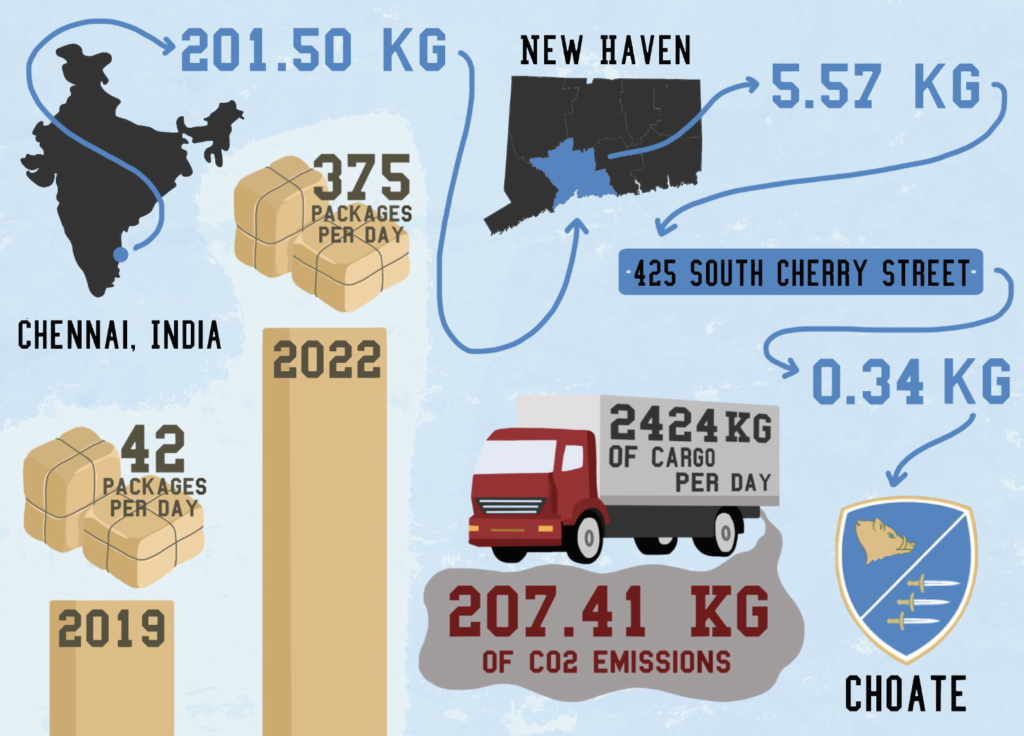
Online shopping surged by 32% in 2020, according to the U.S. Census Bureau. This trend has reflected in Choate’s mailroom, as the number of packages that the School receives each day has skyrocketed since the start of the 2020–21 school year.
In October 2019, the mailroom received an average of 42 packages daily. Just a year later, but well into the pandemic, this number increased by some 620% to an average of 260 packages per day. Now, after two years of the pandemic, the number of packages has shot up even more. Between January 11 and 12, the mailroom, which serves 667 boarding students and over 100 faculty members, received 750 packages. Typically, packages surge at the start of the school year, before the December holidays, and around Valentine’s Day.
For many, online ordering is simply safer and more efficient than going out to a store. Ella Mulhearn ’24 orders snacks and toiletries from Amazon, in part because she can no longer shop at Walmart due to Choate’s ongoing pandemic restrictions. Conveniently, her orders from Amazon arrive within days. “The dining hall has more options than last year, so I’m not ordering microwavable mac ‘n cheese and other things like that, but I still order a few snacks,” on a regular basis, she said.
In a similar vein, Dr. Amber Hodge’s online ordering has been affected by the shutdown of many independent businesses. Dr. Hodge most commonly orders books and some household items from Amazon. “That’s been a really big impact as an English teacher, because I really like supporting independent bookstores — a ridiculous amount have had to close and many have reduced their hours or limited their inventory,” they said. According to the American Booksellers Association, more than 50 of their member bookstores shut down in the first year of the pandemic.
Still, as the School’s individual orders accumulate, a sizable carbon footprint is left behind. Ms. Sarah Case, a mailroom associate, estimated that 95% of packages that the mailroom receives are from Amazon. Each of those packages weighs 15 pounds, or 6.8 kilograms, on average — adding up to a cargo weighing 2424 kg. From there, one can attempt to trace each package’s journey, from production to delivery, in order to determine the total amount of carbon emitted. Say that Choate’s Amazon packages originate in Chennai, India, where Amazon manufactures their house-brand products. A cargo of that weight’s trip from Chennai to New Haven would emit about 201.50 kg of carbon dioxide. A second trip to Amazon’s Wallingford warehouse would emit 5.57 kg. Finally, the delivery-truck drive down Route 5 to Choate would add 0.34 kg. Add that up, and of the 375 packages delivered on a single day this January, it took approximately 207.41 kg of carbon dioxide to transport those Amazon packages from the factory where they were made to the Choate campus.
To put that in perspective, a single day of Choate’s online package-ordering emissions equals those of four trees emitting carbon for ten years, according to a greenhouse-gas conversion by the Environmental Protection Agency. Around two and a half years ago, though, one day of shipping Choate’s Amazon orders emitted around 24.49 kg of carbon dioxide — an 88% decrease from this year’s number.
However, a single number doesn’t reveal the full extent of the effects of online orders. Transporting the finished product to customers is only one of many environmentally unfriendly steps that come along with online ordering. Other parts of the supply chain churn out greenhouse gases, such as cutting trees down to make packaging.
Even though it is complex to determine the precise environmental impact, there are ways to minimize carbon emissions from online ordering, such as ordering items in bulk to reduce ordering frequency. The first step, of course, is simple awareness that small habits can multiply to create a significant environmental impact.



